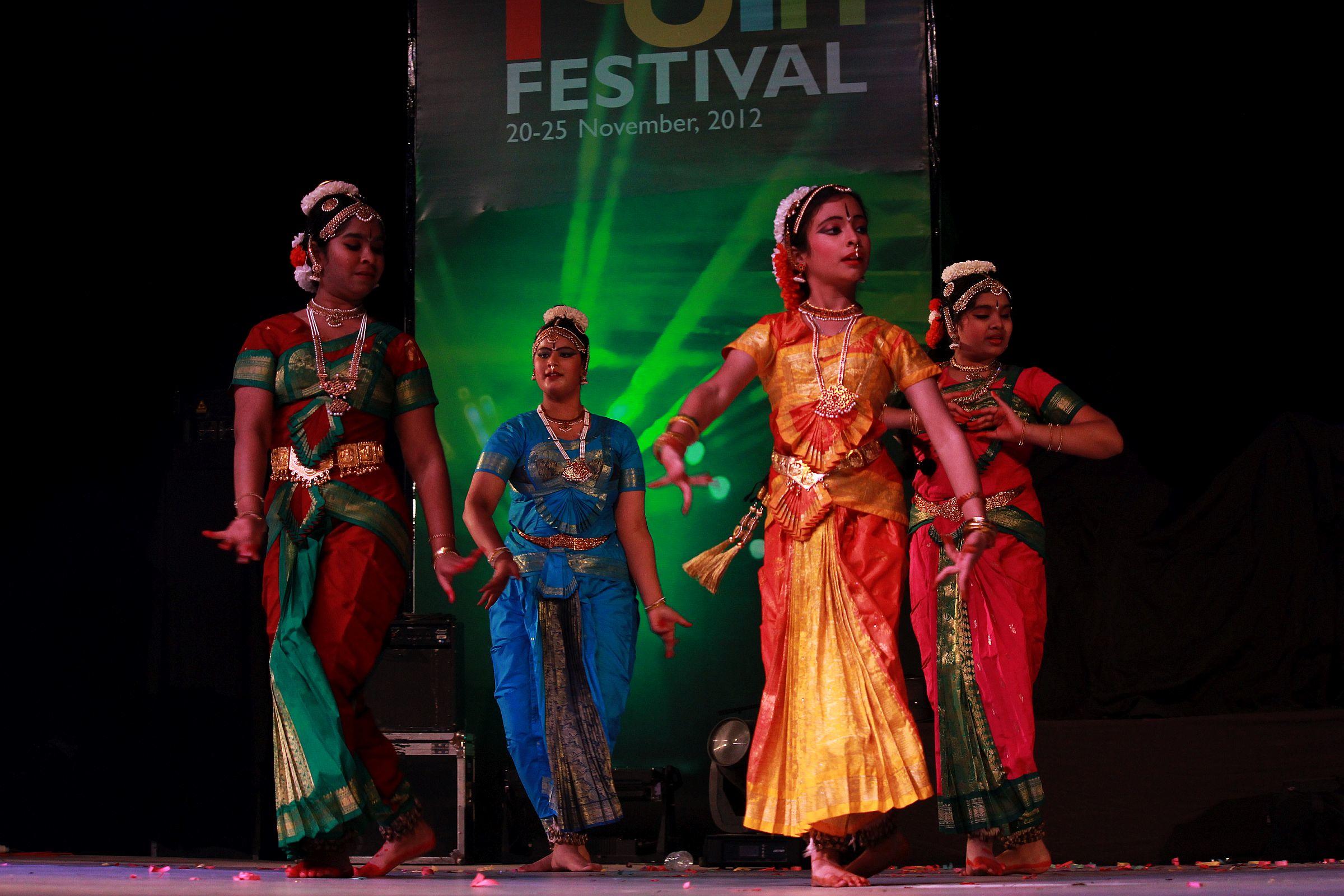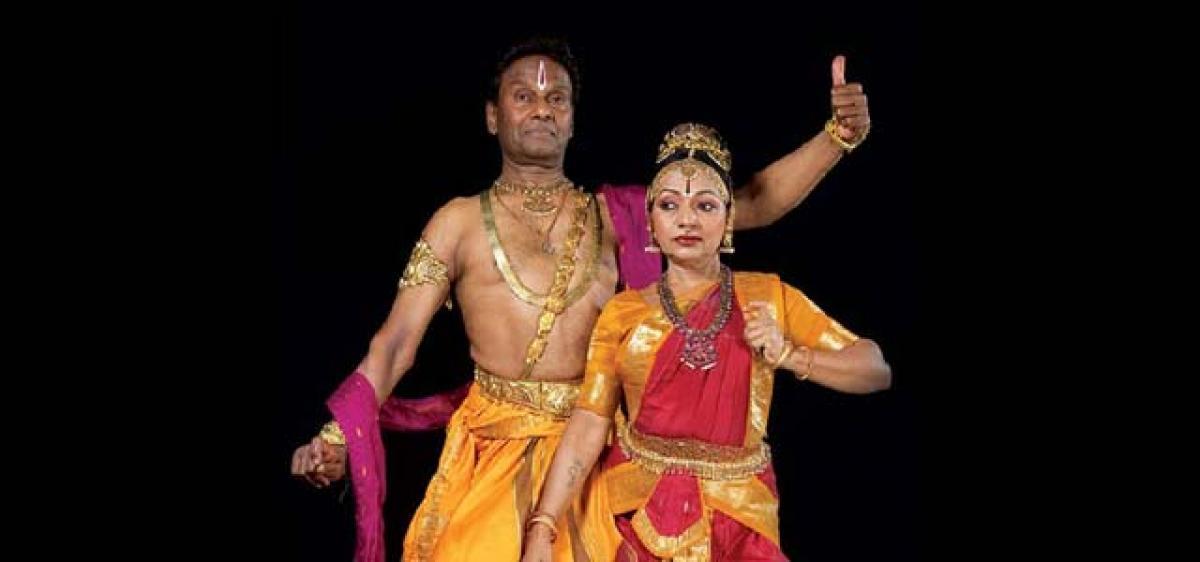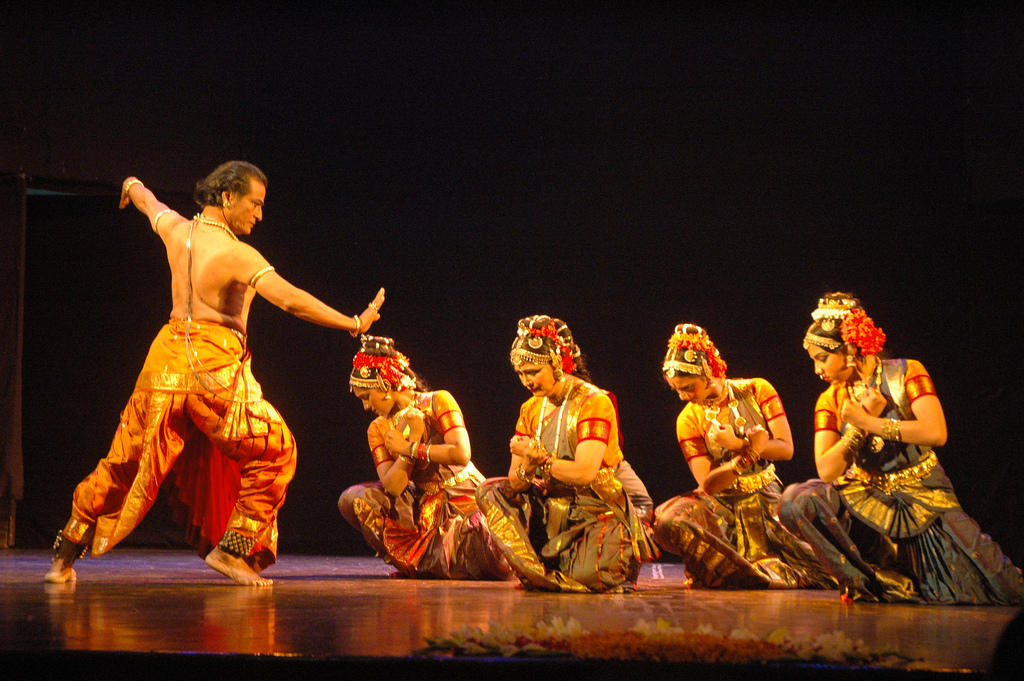The traditional dance form known as Kuchipudi first emerged in the Indian state of Andhra Pradesh in the village of Kuchipudi, from which it got its name. This ancient Indian dance is characterized by exquisite footwork, elegant motions, and nuanced facial emotions. The Kuchipudi dance form combines aspects of expressive dance (Nritya) and pure dance (Nritta), along with dance-based storytelling (Natya).
Learn about the history of Bharatnatyam.
The history of Kuchipudi is extensive, having its beginnings in the third century BCE. A troupe of nomadic actors, known as Bhagavathalu, originally performed it. They would move from village to village presenting plays and dances based on Hindu mythology. Kuchipudi developed as a religious art form, with roots in the ancient Hindu Sanskrit literature "Natya Shastra." It has historical associations with temples, spiritual traditions, and itinerant poets.
This historic dancing style is mentioned in books from the 15th century such as "Machupalli Kaifat" and copper inscriptions from the 10th century. It is generally accepted that the modern form of the Kuchipudi dance was created, organized, and methodized in the 17th century by Tirtha Narayana Yati, a sannyasin of the Advaita Vedanta sect, and his student Siddhendra Yogi. Kuchipudi's performance repertoire typically consists of an invocation, dharavu, a brief dance, nritta, a pure dance, and nritya, an expressive dance. These pieces are generally focused on Lord Krishna and the Vaishnavite tradition.

Kuchipudi developed a unique style and technique over time, transforming it into a more sophisticated and refined art form. Currently acknowledged as one of India's foremost classical dance styles, it is showcased both domestically and globally. A prayer to the gods usually opens a Kuchipudi performance, which then features a number of pure and expressive dance movements and dance-based narratives. Hindu mythology frequently serves as the inspiration for the shows' themes, and the dancers represent a variety of gods, goddesses, and other mythological figures.

Tracing Kuchipudi History
The Bhagavathalu, a troupe of itinerant actors who performed dramas and dances based on Hindu mythology as they travelled from village to village, has been particularly associated with Kuchipudi. The dancing style bears the village's name, Kuchipudi, because it was rumoured that these performers were from the Andhra Pradesh village. Kuchipudi saw a period of substantial development and refinement during the medieval era. As the Bhagavathalu persisted in performing and honing their craft, Kuchipudi started to take shape as a unique dance style with its own technique and flair.
Learn about the evolution of the Kathak dance style.
Kuchipudi was greatly influenced by the famous poet and musician Siddhendra Yogi in the fifteenth century. He is recognized for having turned the dance from primitive folk art into an elegant and polished classical dance form. In addition, Siddhendra Yogi, inarguably, one of the first recognized Kuchipudi dance teachers penned a number of plays and dance dramas that are still essential pieces of Kuchipudi repertoire.
Carry on the history of dance and learn with dance classes in Delhi.
Kuchipudi has persisted in evolving and changing with the times in the present era. The Andhra Pradesh-based Kuchipudi Art Academy was founded in 1958 with the intention of advancing and conserving the dancing style. The institution has been instrumental in preserving the art form's vitality and in educating the next generation of Kuchipudi dancers. Kuchipudi is performed both domestically and abroad and is now acknowledged as one of India's foremost traditional dance styles. Kuchipudi's traditions and tenets have been upheld while choreographers and dancers experiment with new topics and forms in order to fit contemporary tastes in dance.
Discover the story of the Odissi dance.
Repertoire of Kuchipudi Classical Dance
The goal of a Kuchipudi dance drama is to execute the dance in a lively and expressive way. Not only does it involve dancing, but Vachikavinayam, one of the key elements of the dance style, also incorporates theater. The primary purpose of this dance is to portray the stories from Lord Krishna's life. Here are a few of Kuchipudi's core tenets:
- Tala and Layam: The accompanying musicians construct the beat, or tala, to which Kuchipudi is performed. Throughout the performance, the dancer must be able to keep the tala's rhythm and possess a keen sense of timing. The dancer must be able to modify their motions to correspond with the beat of the music. The tempo, or speed, of the rhythm, is also crucial.
- Abhinaya: This is the art of expressing oneself via gestures and facial expressions. Kuchipudi dancers must be able to use their expressions and movements to tell tales and emote. Abhinaya takes years to learn via training and practice.
- Natya: Kuchipudi is more than just a type of pure dance; it also incorporates Natya or a narrative with dance. The dancer must embody Hindu mythological figures through their gestures and facial expressions. As music and spoken or sung words are frequently used to accompany the narrative, the dancer must be able to time their movements to match the conversation and music.
- Rasa: This is the performance's emotional flavour or essence. The dancer in Kuchipudi needs to be able to portray the right rasa, or feeling, for every scene or character. Love, happiness, hatred, courage, grief, contempt, fear, and amazement are examples of rasas.
- Lasya and Tandava: Kuchipudi dancing technique entails striking a balance between these two dance styles. Tandava is the more dynamic and lively style of dance, whereas Lasya is the more elegant and fluid style. For the dancer to produce a harmonious and well-balanced performance, these two elements must be able to be blended together.
Learn about the origins of the Kathakali dance style.
Tarangam and Kavutvam Styles of Kuchipudi
In Kuchipudi, a dance called tarangam is performed by the dancer while holding a pot on their head and dancing on the edges of a brass plate. In this dancing form, this water-filled pitcher is regarded as a meditative tool. Kavutvams include the Nritya in their Kuchipudi dance, which features acrobatic techniques.

Kuchipudi Costume
A female Kuchipudi dancer dons a vibrant sari that is pleated and opens like a hand fan when the dancer bends or stretches her legs while showcasing amazing footwork. The male character dons a dhoti. The female dancer usually wears light makeup that is complemented by traditional jewellery from the area that adorns her arms, neck, nose, and ears. Her waist is adorned with a light metallic belt made of brass or gold, and her ankles are wrapped in a leather anklet with tiny metallic bells called ghunghroo, which make rhythmic noises while she executes intricate footwork.
Explore the myriad hues of Manipuri dance style.
The hair of a female Kuchipudi dancer is styled in a tribhuvana manner, which symbolizes the three worlds and is frequently adorned with flowers. Her braids are done neatly. Her expressions are emphasized by the black collyrium that surrounds them. Certain characters and shows may require unique costumes and props; for instance, the dancer portraying Lord Krishna may wear a crown made of peacock feathers.
Musical Accompaniments
A Sutradhara, also known as a Nattuvanar, leads the group during a Kuchipudi performance and serves as the conductor for the entire show. He creates a rhythmic beat with cymbals and recites the melodic phrases. The conductor, another vocalist, or occasionally the actor-dancers sing the story or spiritual message. The flute, mridangam, tambura, veena, and cymbals are typically used as musical instruments.
Unravel the origins of Mohiniyattam, a classic among classics.
Famous Kuchipdui Dancers
Vempati Chinna Satyam
Many people agree that one of the best Kuchipudi dancers and choreographers of all time is Dr. Vempati Chinna Satyam. After studying under the renowned Kuchipudi dance teacher, Tadepalli Perayya, Satyam founded the Kuchipudi Art Academy in Chennai, which has produced many of the world's best Kuchipudi dancers.
Find amazing dance classes in Mumbai.
Sobha Naidu
Another well-known Kuchipudi performer who has had a major impact on the art genre is Sobha Naidu. She has given several performances both domestically and internationally, and has received numerous honors for her achievements, such as the Padma Shri and the Sangeet Natak Akademi Award.
Ananda Shankar Jayant
A well-known Kuchipudi dancer, choreographer, and scholar, Dr. Ananda Shankar Jayant has played a significant role in advancing the art form and increasing public understanding of its cultural value and historical background. He has won numerous honors, including as the Sangeet Natak Akademi Award and the Padma Shri.
Lose yourself in the unique history of the Sattriya dance form.

Vyjayanthi Kashi
Prominent Kuchipudi performer Vyjayanthi Kashi has been around for more than forty years. She has received instruction from a number of top Kuchipudi dance teachers and has created her own style that combines modern and traditional Kuchipudi components.
Blend into the living art tradition of the Chhau dance form.
Raja and Radha Reddy
Well-known Kuchipudi performers Raja and Radha Reddy have given several performances both domestically and internationally. They have received multiple honors, including the Padma Shri and the Sangeet Natak Akademi Award, in recognition of their strong and energetic dancing style.
Uma Muralikrishna
Hailing from Kerala, Uma Muralikrishna has been teaching and performing Kuchipudi for more than thirty years. She has won multiple honors for her contributions to the art form and is well-known for her elegant and flowing dancing technique.
Learn how to dance Kuchipudi and more with a dance class near me on Superprof.















